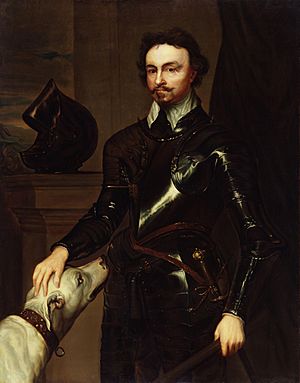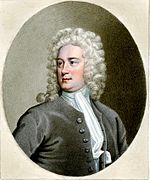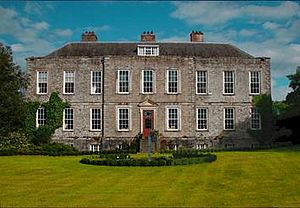Maurice Eustace (Lord Chancellor) facts for kids
Sir Maurice Eustace (born around 1590 – died 1665) was an important Irish landowner, politician, and judge in the 1600s. He ended his career as the Lord Chancellor of Ireland, which was a very high legal position. However, he often felt he wasn't right for the job, and many people agreed he struggled in this role.
Contents
Early Life and Family Background
Maurice Eustace was born around 1590 at Castlemartin, in County Kildare, Ireland. He was the oldest of three sons. His family, the Eustaces of Castlemartin, were a branch of a well-known "Old English" family. Unlike some of their relatives, Maurice's family was known for being loyal to the English King. Maurice later managed to get back much of the land that his relatives had lost.
His family had different views on religion. While Maurice himself was a Protestant, he was very open-minded. He even tried to get more rights for Catholics.
A Career in Law and Politics
Maurice Eustace went to Trinity College Dublin. After finishing his studies, he became a teacher there, specializing in Hebrew. He later left money in his will to keep the Hebrew teaching program going at Trinity.
However, Maurice really wanted to work in law. He joined Lincoln's Inn, a famous legal school in London. He also wanted a career in politics. His father had good connections with important officials in Ireland, which helped Maurice get started.
After becoming a lawyer, he returned to Dublin by 1630. He quickly became a very successful lawyer, earning a lot of money. He aimed for the important job of Prime Serjeant, a top legal advisor to the Crown.
In 1634, he became a member of the Irish House of Commons for Athy. Maurice strongly supported the powerful leader of Ireland, Thomas Wentworth, 1st Earl of Strafford. Wentworth admired Eustace's honesty and skill, and he made him a knight.
This friendship caused problems between Eustace and the Lord Chancellor, Adam Loftus, who was against Wentworth. Maurice became Prime Serjeant, a position he had worked hard to get.
In 1640, Maurice was re-elected to the Commons for County Kildare and became the Speaker of the House. This meant he led the meetings of the House of Commons. He was known for his fancy speaking style. As Speaker, he also received a large payment of £3000.
Unlike many of Wentworth's friends, Maurice did not suffer when Wentworth was later removed from power and executed in 1641. Maurice was well-liked and respected by many. He remained Speaker until 1647.

During the Civil War
As long as Dublin was controlled by the King's supporters (Royalists), Eustace did well. But he often complained about his property being damaged and his animals being stolen during the Irish Confederate Wars.
He got back his family's old estate, Palmerstown. In 1643, because he was known to understand the problems of Irish Roman Catholics, he was sent to talk with the Irish Confederacy in Kilkenny. He also gained land at Athy and Cong.
However, in 1647, Dublin was taken over by the Parliament's forces. Eustace was arrested and sent to Chester Castle in England, where he stayed for seven years. During this time, he had a son and a daughter with a lady.
After his release, he returned to Dublin. He was briefly arrested again because people thought he was secretly talking to King Charles II. But he was soon released and allowed to practice law again. His loyalty to the King was never truly doubted.
After the King Returned
When King Charles II returned to power in 1660 (this event is called the Restoration), Maurice Eustace's loyalty and experience made him a good choice for a high position. He was also a close friend of the Duke of Ormonde, a very important figure. Because of this, Maurice was made Lord Chancellor of Ireland. He also became one of the Lords Justices of Ireland, who governed Ireland when the Lord Lieutenant was away.
Ironically, Maurice himself was the only one who strongly objected to his new job. He loved country life and wanted to retire to his home, Harristown Castle, which he was rebuilding. He also worried that his age and poor health meant he wasn't fit for such a demanding role. He wrote to the King's Secretary, saying he was "too old to perform any public service."
Lord Justice
As a Lord Justice, Eustace was involved in big arguments about land. Many Roman Catholic Royalists had lost their land during the Cromwellian Settlement in 1652. The new owners were Parliament's supporters. Maurice felt strongly that the original Catholic owners should get their land back. He also believed in equal rights for Catholics, even though he was a Protestant.
This put him against his fellow Lords Justices, who supported the new landowners. Maurice tried hard to help the Royalists get some land back through the Act of Settlement 1662. But this struggle tired him out. He was relieved when the Duke of Ormonde arrived in Dublin in 1662, allowing him to step down as Lord Justice.
Lord Chancellor
Maurice Eustace's prediction that he would not succeed as Lord Chancellor came true. Political fights, illness, periods of sadness, and family problems made it very hard for him to do his job in his last years. He was also disappointed that his efforts to allow more religious freedom for Roman Catholics did not work. The Duke of Ormonde, while personally tolerant, did not support these changes.
In 1663, Eustace became very ill and could not perform his duties for a while. Complaints about his inability to do the job reached the English Lord Chancellor. However, Ormonde remained loyal to Eustace, pointing out his long history of loyalty to the King. It was hard to find a replacement, so the question of his dismissal was still being discussed when he died.
His Family and Fortune
Maurice Eustace was always good with money. Despite his job troubles, he became very wealthy. He got back most of the Eustace family lands that had been lost. He owned land in several counties and helped improve the town of Baltinglass. He also bought land near Chapelizod, which later became part of Phoenix Park.
Maurice's marriage was childless. During his time in Chester, he had a son (also named Maurice) and a daughter, Mary. He wanted to provide for them, especially since he was still friendly with their mother. He had promised her to leave his lands to their son. However, he had also publicly promised to leave his lands to his nephew, another Maurice.
Deciding how to divide his wealth between his son and his two nephews became a big worry for him. Even his friend Ormonde told him to focus more on his official duties. In his will, he divided his property between his nephews. This decision led to disagreements and legal battles after his death.
The younger Sir Maurice, his nephew, eventually gained possession of Harristown and his Dublin townhouse on Eustace Street.

Later Life and Legacy
In 1665, even though he was over seventy, Maurice Eustace seemed to be getting better. At his niece Mary's wedding, he was described as "as brisk as a bee." He gave the couple his estate at Calverstown as a wedding gift.
Soon after, he had a stroke and died. He was buried privately at Castlemartin. Three weeks later, the government held an official memorial service for him in St. Patrick's Cathedral to honor his service to the Crown.
His name lives on in Eustace Street in Dublin city center, where his large and admired townhouse once stood.
|



